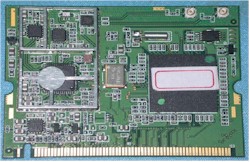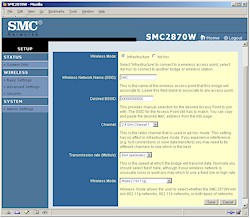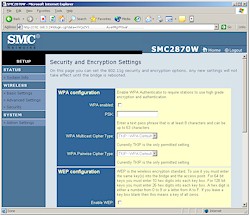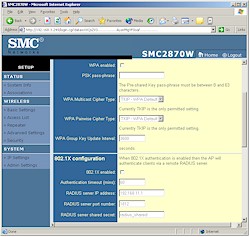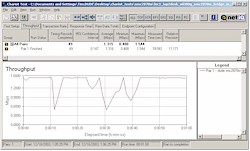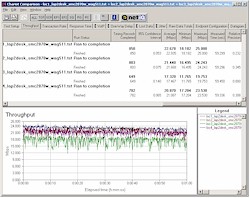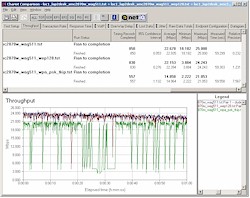Introduction and Product Details
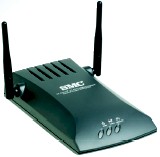
| SMC EZ Connect g 2.4GHz Wireless Ethernet Adapter | |
|---|---|
| Summary | PRISM based 802.11g multimode device. Can operate as bridge or AP with WDS-based bridging. |
| Update | 12/20/2003 – Removed references to supporting WPA in AdHoc mode |
| Pros | • Can run as an AP with WDS-based bridging / repeating or wireless Bridge • Supports WPA in bridge mode |
| Cons | • Firmware load required to switch between AP and Bridge modes • Non-upgradeable antennas • WPA in Bridging mode not robust |
SMC’s SMC2870W is a product that seems to be having an identity crisis. The silkscreen on the product says “EZ Connect g 2.4GHz 54Mbps Wireless Ethernet Adapter SMC2870W”, but its User Manual, web page and product brochure refer to it by that moniker and also as a “Wireless Ethernet Bridge”.
In fact, the 2870W can function as an 802.11g access point that supports WDS-based wireless bridging and repeating. But it also functions in what SMC calls “Bridge” mode, but which functions more like an 802.11g Ethernet adapter capable of operating in Infrastructure and Ad Hoc modes.
The 2870W comes in a plastic SMC-grey enclosure with a footprint slightly smaller than a VHS cassette, sloped front and sides, and mounting screw slots on its bottom. The PWR, wireless Tx / Rx, and Ethernet Link / Act indicators are on the sloped front of the box and are somewhat dim when viewed when the unit is sitting on a shelf at eye-level. Power and 10/100 Ethernet connectors and a Reset / Reset-to-Defaults switch are all on the rear panel.
Tip: The 2870W’s Ethernet connection does not support auto MDI / MDI-X, nor does it have a Normal / Crossover switch, so setup can require some experimentation depending on the mode you’re using and what you’re connecting to. SMC thoughtfully includes a crossover cable (although it’s not identified as such), but not a normal UTP cable.
The product is based on Ubicom’s IP2022 Network Processor and uses a AirVast Technology WN360g mini-PCI radio based on Intersil / GlobespanVirata / Conexant’s PRISM GT chipset (Figure 1).
Figure 1: The radio
(click on the image for a full-sized view)
The radio is connected to two hard-wired external dipole antennas, but since the antennas connect to the board via miniature connectors, die-hard hackers could always rig up higher-gain substitutes.
Examination of the board revealed that the 10/100 Ethernet connector is wired to support Power over Ethernet (PoE) use, although SMC neither specifies nor supports this option.
Setup and Admin
The 2870W’s schizophrenic nature really becomes apparent when setting up the product. The setup confused me so much that I called SMC to get an explanation, which I’ll now pass on.
Admin is supported via both a web-based interface and a Windows (98SE, Me, 2000, XP) application. The application finds the 2870W (which ships with a default IP address of 192.168.2.25), and allows you to configure some of its settings.
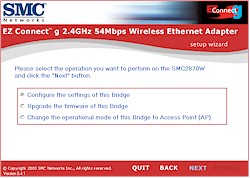
Figure 2: Setup application
It also – as Figure 2 shows – allows you to change the 2870W from its default Bridge mode to Access Point mode. This actually involves a firmware reload and device reboot, which the application takes care of using embedded firmware files. Unfortunately, this personality change resets the IP address to the default, which I found annoying.
If you run a non-Windows OS, or simply would rather use the web-based interface, you’ll need to set your computer to an address in the 192.168.2.X subnet, then connect to the 2870W’s default IP address.
Figure 3: Bridge mode Basic Settings, Web interface
(click on the image for a full-sized view)
Figure 3 shows the “Basic” settings page for the Bridge mode. Most of these are self-explanatory, but I think SMC could have cleaned things up a bit – get rid of the “000000000000” BSSID setting, gray out the channel setting in Infrastructure mode, etc.
If you want to switch modes via the Web interface, you’ll need the appropriate firmware file on a local computer and then upload them from the Admin Settings page.
By the way, SMC explained that the reason for this firmware swap was due to limited memory in the 2870W. I guess they saved some money that way, but it remains to be seen whether customers will be ok with the trade-off.
The web-based interface is very responsive if you’re using Internet Explorer. The going is very slow, however, if you use Mozilla or a recent version of Netscape based on the Mozilla engine.
Features
The big news is that the 2870W is the first wireless bridge to support Wi-Fi Protected Access (WPA). For reasons too long to go into here, supporting WPA in bridging devices is especially challenging, but appears that SMC (or more likely the folks at Ubicom who make the processor that the 2870W is based on) has managed to come up with a working implementation.
Figure 4: Bridge mode Security Settings, Web interface
(click on the image for a full-sized view)
As Figure 4 shows, WPA-PSK with TKIP encryption is the only mode supported to similarly-equipped Access Points or Wireless routers. WPA won’t work between two 2870Ws, because it isn’t supported in AdHoc mode until its next version. If you can’t or don’t want to use WPA, good ol’ 64 and 128 bit WEP is also available.
Tip: Running in WPA mode was a little less forgiving than without it. I found you must explicitly enter both the SSID and BSSID of the AP you want to connect with or it won’t work. When running with WEP or without any encryption at all, I could use a blank SSID and didn’t have to set the BSSID at all and things connected just fine.
When you switch to Access Point mode, you’ll find that WPA-PSK / TKIP is still the only WPA mode supported. But as shown in Figure 5, the 2870W also offers the ability to pass 802.1x authentication requests off to an external RADIUS server. Of course, 64 / 128 bit WEP is also supported (it’s below the 802.1x configuration section on the Security page).
NOTE: In Access Point mode, WPA is supported only between client and AP. WDS-based bridged / repeated AP-to-AP data can be WEP encrypted, but not secured via WPA.
Figure 5: AP mode Security Settings, Web interface
(click on the image for a full-sized view)
AP mode also gives you a few more “Advanced” settings to mess with (Fragmentation and RTS threshold and Beacon and DTIM periods) and provides access to the Repeating feature.
Repeating supports wireless connection between up to six devices that support WDS-based bridging, as well as letting clients associate and communicate through each AP. So multiple APs can be used to extend your wireless LAN’s range without the need to run Ethernet to connect them.
The Access List feature lets you list 30 MAC address which are allowed to associate, but it doesn’t show a pick-list of associated clients or allow a pre-made list to be loaded in order to ease setup.
Monitoring features in both modes is very basic and provided mainly via the System Info page. There are no traffic statistics and you only get a list of associated client MAC addresses in AP mode, and in-range APs and AdHoc stations when set to Bridge mode.
One last note is that the 2870W supports the PRISM Nitro throughput-enhancement features. But they’re enabled by default and you can’t turn them off.
Wireless Performance
Testing Notes:
– All tests were run with the defaults of 54g-Auto mode and 11b protection disabled
– Signal strength readings were not available
– Frame bursting (PRISM Nitro) was enabled in the 2870W only
– AP tests were run with a NETGEAR WAG511 CardBus card [reviewed here] (Atheros chipset)
– Bridge tests were run with an ASUS WL-300g Access Point(Broadcom’s AirForce chipset). The WL-300g was set to 54g- Auto mode, 11b protection disabled and frame-bursting disabled.
I tested the 2870W in both modes and found it fared much better when used as an access point. Chariot’s maximum throughput testing seemed just too much for the Bridging mode to handle with typical results shown in Figure 6.
Figure 6: Bridge mode – Location 1 throughput
(click on the image for a full-sized view)
Enabling WPA in Bridge mode caused the 2870W’s behavior to become even less robust. In order to generate the complete one minute run shown in Figure 7, I had to limit the test throughput rate to 1.544Mbps (one of Chariot’s presets). Raising the speed to even 2.048Mbps caused the product to lock up just a few seconds into the test. (After lockup, the 2870W’s admin interface still worked and its ability to pass traffic recovered after a minute or so.)
Figure 7: Bridge mode – Location 1 throughput – WPA-PSK / TKIP enabled
(click on the image for a full-sized view)
I switched to AP mode for my four-location throughput tests and, as Figure 8 shows, the 2870W seemed to settle down and perform much more consistently
Figure 8: AP mode – Four location throughput
(click on the image for a full-sized view)
I also checked throughput with 128bit WEP and WPA-PSK / TKIP enabled, with results shown in Figure 9.
Figure 9: AP mode – Security mode comparison
(click on the image for a full-sized view)
Although no throughput hit was obtained by enabling WEP, I was surprised to see an almost 10% hit with WPA /TKIP kicked in, since I had seen virtually no difference in this mode in other testing with Atheros-based clients. But I suspect the culprit may be the mixing of Atheros and PRISM-based devices.
802.11g Wireless Performance Test Results
| Test Conditions
– WEP encryption: DISABLED |
Firmware/Driver Versions
AP f/w: |
||||
|---|---|---|---|---|---|
| Test Description | Signal Strength (%) | Transfer Rate (Mbps) | Response Time (msec) | UDP stream | |
| Throughput (kbps) | Lost data (%) | ||||
| Client to AP – Condition 1 | 0 | 22.9 [No WEP] 22.4 [w/ WEP] |
1 (avg) 2 (max) |
499 | 0 |
| Client to AP – Condition 2 | 0 | 21.7 | 1 (avg) 5 (max) |
499 | 0 |
| Client to AP – Condition 3 | 0 | 17.5 | 1 (avg) 2 (max) |
500 | 0 |
| Client to AP – Condition 4 | 0 | 21.1 | 1 (avg) 2 (max) |
500 | 0 |
See details of how we test.
Wrap Up
As with any first-in-class product, the SMC2870W has its share of rough edges and work left to be done. I was really annoyed by the slowness of the admin interface throughout most of my testing, but glad to see that this problem was solved by using Internet Explorer – though I don’t consider that a “fix”. And the confusing product nomenclature and lack of support for both Normal and “crossover” based connections also need work.
But Job #1 should be improving WPA-enabled performance in Bridge mode, since that’s the product’s chief claim-to-fame. Though it currently does work, my experience with it says it’s not robust enough for heavy use.
What’s not likely to be fixed, however, is the firmware-load-to-change-mode “feature”. If this really is due to memory mis-sizing, then only a follow-on product (with larger memory) or major rewrite of the firmware will fix something that I think will generate a fair share of Tech Support calls.
Although I give SMC points for pushing the wireless product envelope, there are just too many quirks for my taste. But that could just be me…

